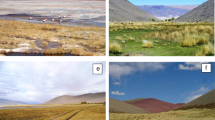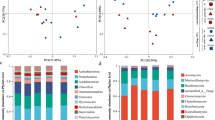Abstract
A characterization of the spatial distribution of soil biota (nematodes, microarthropods, large soil invertebrates) in plant communities of the southeastern sector of the Bolshezemelskaya tundra (Komi Republic, environs of Vorkuta) is given. For all groups of soil invertebrates studied, an aggregated distribution was noted, in which the body size of the organism plays a certain role. It is shown that the level of moisture in the soils of tundra ecosystems does not significantly affect the spatial distribution of various groups of soil organisms.


Similar content being viewed by others
REFERENCES
Babenko, A.B., Adaptation of collembolans to the temperature conditions of high latitudes, Usp. Sovrem. Biol., 1993, vol. 113, pp. 223–227.
Block, W., Cold or drought: the lesser of two evils for terrestrial arthropods?, Eur. J. Entomol., 1996, vol. 93, pp. 325–340.
Bokhorst, S., Phoenix, G.K., Bjerke, J.W., Callaghan, T.V., Huyer-Brugman, F., and Berg, M.P., Extreme winter warming events more negatively impact small rather than large soil fauna: shift in community composition explained by traits not taxa, Global Change Biol., 2012, vol. 18, pp. 1152–1162. https://doi.org/10.1111/j.1365-2486.2011.02565.x
Borcard, D. and Legendre, P., Environmental control and spatial structure in ecological communities: an example using oribatid mites (Acari, Oribatei), Environ. Ecol. Statist., 1994, vol. 1, pp. 37–61.
Chernov, Yu.I., The dependence of the composition of the animal population of soils and sod on the vegetation cover pattern in some types of tundra, Probl. Severa, 1964, no. 8, pp. 254–267.
Convey, P., Block, W., and Peat, H.J., Soil arthropods as indicators of water stress in Antarctic terrestrial habitats?, Global Change Biol., 2003, vol. 9, pp. 1718–1730. https://doi.org/10.1046/j.1529-8817.2003.00691.x
Coulson, S.J., Hodkinson, I.D., and Webb, N.R., Microscale distribution patterns in high arctic soil microarthropod communities: the influence of plant species within the vegetation mosaic, Ecography, 2003, vol. 26, pp. 801–809.
Decaëns, T., Macroecological patterns in soil communities, Global Ecol. Biogeogr., 2010, vol. 19, pp. 287–302. https://doi.org/10.1111/j.1466-8238.2009.00517.x
Ettema, C.H. and Wardle, D.A., Spatial soil ecology, Trends Ecol. Evol., 2002, vol. 17, pp. 177–183.
George, P.B.L. and Lindo, Z., Application of body size spectra to nematode trait-index analyses, Soil Biol. Biochem., 2015, vol. 84, pp. 15–20. https://doi.org/10.1016/j.soilbio.2015.02.007
Gilyarov, M.S., The ratio of the size and abundance of soil animals, Dokl. Akad. Nauk SSSR, 1944, no. 6, pp. 283–285.
Guo, Y., Gao, M., Liu, J., Zaitsev, A.S., and Wu, D., Disentangling the drivers of ground-dwelling macro-arthropod metacommunity structure at two different spatial scales, Soil Biol. Biochem., 2019, vol. 130, pp. 55–62. https://doi.org/10.1016/j.soilbio.2018.12.002
Hansen, R.R., Hansen, O.L.P., Bowden, J.J., Treier, U.A., Normand, S., and Hoye, T., Meter scale variation in shrub dominance and soil moisture structure arctic arthropod communities, Peer J., 2016, pp. 1–18. https://doi.org/10.7717/peerj.2224
Hodkinson, I.D., Babenko, A., Behan-Pelletier, V., Bocher, J., Boxshall, G., Brodo, F., Coulson, S.J., Smet, W., Dózsa-Farkas, K., Elias, S., Fjellberg, A., Fochetti, R., Foottit, R., Hessen, D., Hobaek, A., Holmstrup, M., Koponen, S., Liston, A., Makarova, O., Marusik, Y.M., Michelsen, V., Mikkola, K., Mustonen, T., Pont, A., Renaud, A., Rueda, L.M., Savage, J., Smith, H., Samchyshyna, L., Velle, G., Viehberg, F., Vikberg, V., Wall, D.H., Weider, L.J., Wetterich, S., Yu, Q., and Zinovjev, A., Terrestrial and freshwater invertebrates, in Arctic Biodiversity Assessment. Status and Trends in Arctic Biodiversity, Meltofte, H., Ed., Akureyri: CAFF, 2013, pp. 195–223.
Holland, J.D., Fahrig, L., and Cappuccino, N., Body size affects the spatial scale of habitat–beetle interactions, Oikos, 2005, vol. 110, pp. 101–108.
Høye, T.T., Bowden, J.J., Hansen, O.L.P., Hansen, R.R., Henriksen, T.N., Niebuhr, A., and Skytte, M.G., Elevation modulates how arctic arthropod communities are structured along local environmental gradients, Polar Biol., 2018, vol. 41, pp. 1555–1565. https://doi.org/10.1007/s00300-017-2204-2
Joschko, M., Fox, C.A., Lentzsch, P., Kiesel, J., Hierold, W., Kruck, S., and Timmer, J., Spatial analysis of earthworm biodiversity at the regional scale, Agricult. Ecosyst. Environ., 2006, vol. 112, pp. 367–380. https://doi.org/10.1016/j.agee.2005.08.026
Klironomos, J.N. and Kendrick, B., Relationships among microarthropods, fungi, and their environment, Plant Soil, 1995, vol. 170, pp. 183–197.
Klironomos, J.N., Rillig, M.C., and Allen, M.F., Designing belowground field experiments with the help of semi-variance and power analyses, Appl. Soil. Ecol., 1999, vol. 12, pp. 227–238.
Kudrin, A.A., Dolgin, M.M., Kolesnikova, A.A., Konakova, T.N., and Taskaeva, A.A., Features of the spatial distribution of soil fauna in pine forests of northern taiga (Komi Republic), Vestn. Sev. Arkt. Fed. Univ., 2014, no. 1, pp. 72–83.
Kudrin, A.A., Konakova, T.N., and Taskaeva, A.A., Communities of soil nematodes of various tundra phytocenoses differing in the development level of the shrub layer, Russ. J. Ecol., 2019, vol. 50, pp. 526–534. https://doi.org/10.1134/S1067413619060092
Lindo, Z., Warming favours small-bodied organisms through enhanced reproduction and compositional shifts in belowground systems, Soil Biol. Biochem., 2015, vol. 91, pp. 271–278. https://doi.org/10.1016/j.soilbio.2015.09.003
Mills, A.A.S. and Adl, M.S., Changes in nematode abundances and body length in response to management intensive grazing in a low-input temperate pasture, Soil Biol. Biochem., 2011, vol. 43, pp. 150–158. https://doi.org/10.1016/j.soilbio.2010.09.027
Nielsen, U.N., Ayres, E., Wall, D.H., Li, G., Bardgett, R.D., Wu, T., and Garey, J.R., Global-scale patterns of assemblage structure of soil nematodes in relation to climate and ecosystem properties, Clobal Ecol. Biogeogr., 2014, vol. 23, pp. 968–978. https://doi.org/10.1111/geb.12177
Nkem, J.N., Wall, D.H., Virginia, R.A., Barrett, J.E., Broos, E.J., Porazinska, D.L., and Adams, B.J., Wind dispersal of soil invertebrates in the McMurdo Dry Valleys, Antarctica, Polar Biol., 2006, vol. 29, pp. 346–352. https://doi.org/10.1007/s00300-005-0061-x
Petchey, O.L. and Belgrano, A., Body-size distributions and size-spectra: universal indicators of ecological status?, Biol. Lett., 2010, vol. 6, pp. 434–437. https://doi.org/10.1098/rsbl.2010.0240
Petersen, H., Collembolan communities in shrublands along climatic gradients in Europe and the effect of experimental warming and drought on population density, biomass and diversity, Soil Organisms, 2011, vol. 83, no. 3, pp. 463–488.
Pokarzhevskii, A.D., Gongal’skii, K.B., Zaitsev, A.S., and Savin, F.A., Prostranstvennaya ekologiya pochvennykh zhivotnykh (Spatial Ecology of Soil Animals), Dobrovol’skii, G.V., Ed., Moscow: KMK, 2007.
Ponge, J.-F., Dubs, F., Gillet, S., Sousa, J.P., and Lavelle, P., Decreased biodiversity in soil springtail communities: the importance of dispersal and landuse history in heterogeneous landscapes, Soil Biol. Biochem., 2006, vol. 38, no. 5, pp. 1158–1161. https://doi.org/10.1016/j.soilbio.2005.09.004
Powers, L.E., Freckman, D.W., and Virginia, R.A., Spatial distribution of nematodes in polar desert soils of Antarctica, Polar Biol., 1995, vol. 15, pp. 325–333.
Puzin, C., Bonte, D., and Petillon, J., Influence of individual density and habitat availability on long-distance dispersal in a saltmarsh spider, Ethol. Ecol. Evol., 2018, vol. 31, no. 1, pp. 28–37. https://doi.org/10.1080/03949370.2018.1486888
Saraeva, A.K., Potapov, M.B., and Kuznetsova, N.A., Different-scale distribution of collembola in homogenous ground vegetation: sphagnum moss, Entomol. Rev., 2015, vol. 95, pp. 557–577. https://doi.org/10.7868/S0044513415050098
Scherber, C., Eisenhauer, N., Weisser, W.W., Schmid, B., Voigt, W., Schulze, E.-D., Roscher, C., Weigelt, A., Allan, E., Beßler, H., Bonkowski, M., Buchmann, N., Buscot, F., Clement, L.W., Ebeling, A., Engels, C., Fischer, M.S., Halle, S., Kertscher, I., Klein, A.-M., Koller, R., König, S., Kowalski, E., Kummer, V., Kuu, A., Lange, M., Lauterbach, D., Middelhoff, C., Migunova, V.D., Milcu, A., Muller, R., Partsch, S., Petermann, J.S., Renker, C., Rottstock, T., Sabais, A., Scheu, S., Schumacher, J., Temperton, V.M., and Tscharntke, T., Bottom-up effects of plant diversity on multitrophic interactions in a biodiversity experiment, Nature, 2010, vol. 468, no. 7323, pp. 553–556. https://doi.org/10.1038/nature09492
Stebaeva, S.K., Life forms of springtails (Collembola), Zool. Zh., 1970, vol. 49, no. 10, pp. 1437–1455.
Szujecki, A., Ecology of Forest Insects, Warszawa: Springer, 1987.
Tahseen, Q., Nematodes in aquatic environments: adaptations and survival strategies, Biodiversity J., 2012, vol. 3, no. 1, pp. 13–40.
Turnbull, M.S. and Lindo, Z., Combined effects of abiotic factors on Collembola communities reveal precipitation may act as a disturbance, Soil Biol. Biochem., 2015, vol. 82, pp. 36–43. https://doi.org/10.1016/j.soilbio.2014.12.007
Turnbull, M.S., George, P.B.L., and Lindo, Z., Weighing in: size spectra as a standard tool in soil community analyses, Soil Biol. Biochem., 2014, vol. 68, pp. 366–372. https://doi.org/10.1016/j.soilbio.2013.10.019
Usher, M.B., Some properties of the aggregations of soil arthropods: Collembola, J. Anim. Ecol., 1969, vol. 38, pp. 607–622.
Viketoft, M., Determinants of small-scale spatial patterns: importance of space, plants and abiotics for soil nematodes, Soil Biol. Biochem., 2013, vol. 62, pp. 92–98. https://doi.org/10.1016/j.soilbio.2013.03.012
Woodward, G., Ebenman, B., Emmerson, M., Montoya, J.M., Olesen, J.M., Valido, A., and Warren, P.H., Body size in ecological networks, Trends Ecol. Evol., 2005, vol. 20, no. 7, pp. 402–409. https://doi.org/10.1016/j.tree.2005.04.005
Wu, P. and Wang, Ch., Differences in spatiotemporal dynamics between soil macrofauna and mesofauna communities in forest ecosystems: the significance for soil fauna diversity monitoring, Geoderma, 2019, vol. 337, pp. 266–272. https://doi.org/10.1016/j.geoderma.2018.09.031
Yeates, G.W., Bongers, T., de Goede, R.G.M., Freckman, D.W., and Georgieva, S.S., Feeding habits in soil nematode families and genera: an outline for soil ecologists, J. Nematol., 1993, vol. 25, pp. 315–331.
ACKNOWLEDGMENTS
The authors are grateful to Yu.V. Kholopov and A.A. Rud (Institute of Biology) for help with sampling.
Funding
This work was carried out within the framework of a state assignment on the topics “Distribution, Systematics, and Spatial Organization of the Fauna and population of Terrestrial and Aquatic Animals of Taiga and Tundra Ecosystems of the European North-East of Russia” (project no. Gr RK AAAA-A17-117112850235-2) and “Identification of General Patterns of Formation and Functioning of Peat Soils on the Territory of the Arctic and Subarctic Sectors of the European Northeast of Russia” (project no. Gr AAAA-A17-117122290011-5).
Author information
Authors and Affiliations
Corresponding author
Ethics declarations
Conflict of interest. The authors declare that they have no conflict of interest.
Statement on the welfare of animals. All applicable international, national, and/or institutional guidelines for the care and use of animals were followed.
Rights and permissions
About this article
Cite this article
Taskaeva, A.A., Konakova, T.N., Kolesnikova, A.A. et al. Spatial Distribution of Invertebrates in the Soils of the Southeastern Part of the Bolshezemelskaya Tundra. Biol Bull Russ Acad Sci 48, 94–102 (2021). https://doi.org/10.1134/S1062359021010143
Received:
Revised:
Accepted:
Published:
Issue Date:
DOI: https://doi.org/10.1134/S1062359021010143




